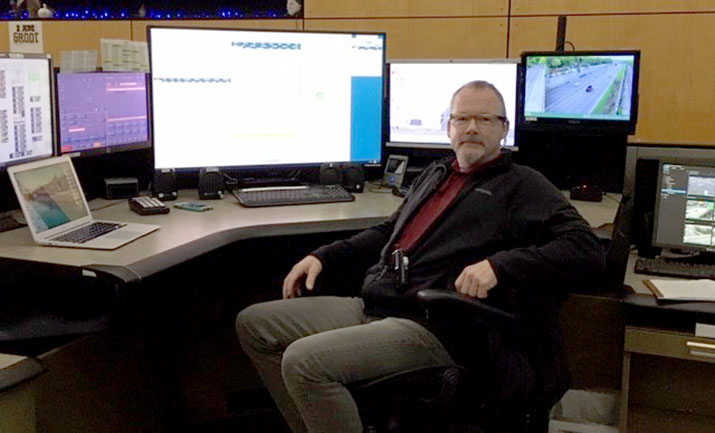‘I’m not gonna let you go.’
May 7, 2020

It was a fluke, really – the fact that dispatcher Marty O’Hehir picked up the 911 call. It could have been any of his fellow dispatchers working that April night at the Regional Transportation Center in Roseville. But Marty ended up being the one to stay on the phone for 22 minutes. Twenty-two minutes to prevent someone from committing suicide. Twenty-two minutes to save someone’s life.
The suicidal caller was a man in his mid-30s. When he called Marty, he was speeding on Interstate 94 in excess of 100 mph. He was determined to die – whether suicide by cop or crash, he didn’t care – but he was serious about it. “He was rock solid on what he was telling me,” remembers Marty. “I believed every word of what he was saying.”
With that, Marty, his partner, and the whole room sprang into action. While Marty spoke to the driver and coordinated a State Patrol squad car to intercept the caller, his partner took notes on what Marty was saying, and the other dispatchers in the room were ready to help. “The whole room went quiet. I could tell,” says Marty. “I had a supervisor behind me and my partner to the right. I had everyone behind me. Whatever information I needed, they were there to help me get it. But everyone was on pins and needles, too.”
Marty usually tries to keep his focus wide so that he’s aware of everything in the room, but as he and the caller spoke, Marty’s field of vision narrowed more and more, until it felt like it was just the two of them. Marty asked the caller what was going on, and he opened up, expressing emotions and frustrations Marty was no stranger to. “I could relate to him on both a professional and personal basis. Regular human feelings and emotions were happening, and in this case, they got the better of him that day.”
Marty kept asking him to pull over, kept him talking, and answered his questions. By this time there were several squad cars following the caller as he drove, and he was worried about what would happen if he pulled over. “They’re there to help,” Marty assured him. “You just have to trust me.” At one point during their talk, the caller decided he wanted to drive all the way up to Duluth. “I’m from there too,” Marty told the caller. “If you want, I’ll drive the whole two-and-a-half hours with you. I’m not gonna let you go.”
Marty has been in dispatch in one way or another since his Navy days in the 1990s. But he had never had a call like this before. After the caller pulled over and Marty heard Trooper Tim Peterson start up a conversation with him, he hung up, knowing the suicidal man would not die that night. The room burst into applause, but “I had to walk out of the room to gather my thoughts. That’s something I’ve never done.” Marty talked to the on-call peer counselor, then went home for the day to process his thoughts. “I’m not gonna lie – it rattled me. But it’s OK. That’s just a human emotion.” After all, Marty continues, helping people is what he does. “It’s why I enjoy my work. I’m here to help, whether it’s a flat tire or a suicidal person.”
A few days later, Marty received a very welcome surprise: The caller called back. He left a message for Marty and Trooper Peterson, thanking them for saving his life. “I could hear the relief in his voice,” Marty recalls. “It made me feel good. I could hear in his voice he was doing much better.”
To Marty, this experience highlights the importance of asking for help. “Whether it’s your friends and family, a dispatcher, clergy, the guy at the taco truck. Just ask for help.” He says that sometimes people apologize for calling 911, but he always assures them, “That’s what we’re here for. Don’t apologize. Don’t be afraid to call 911.”
In this particular case, though, Marty was a bit more specific: “Your life is worth more than just a fleeting decision. I can mend a broken heart, but I can’t fix a dead body.”
If you or someone you know is considering suicide, you can get help. Call 911 or the National Suicide Prevention Lifeline at
800-273-TALK. As Marty says, they’re there to help.

